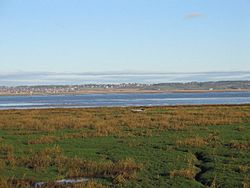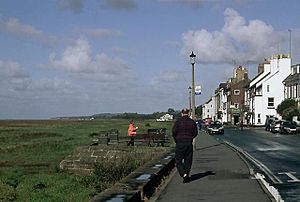Dee Estuary facts for kids
| Site of Special Scientific Interest | |
 |
|
| Area of Search | Merseyside & Cheshire, England & Flintshire, Wales |
|---|---|
| Coordinates | 53°18′32″N 3°09′25″W / 53.309°N 3.157°W |
| Interest | Geological |
| Area | 13679.7 hectares, 33,788.9 acres (136,739,000 m2) |
| Notification | 1954 /1984 |
|
Designations
|
|
| Official name: The Dee Estuary | |
| Designated: | 17 July 1985 |
|---|---|
| Reference #: | 298 |
The Dee Estuary (Welsh: Aber Dyfrdwy) is a very large estuary where the River Dee flows into Liverpool Bay. An estuary is where a river meets the sea.
The estuary begins near Shotton. Here, the river quickly widens to several miles across. It forms the natural border between the Wirral Peninsula in north-west England and Flintshire in north-east Wales.
Contents
How the Dee Estuary Was Formed
The Dee Estuary is special because it's a very wide basin, but not much water flows through it today. Scientists have different ideas about why it's like this.
One idea is that much bigger rivers, like the Severn or Mersey, once flowed into the Dee.
The most common idea is that the estuary was shaped by huge sheets of ice during past ice ages. These glaciers moved southeast from the Irish Sea. They slowly carved out a wide, shallow channel. This channel went through softer rocks like sandstone and mudstone. Over time, this channel filled up with sand, gravel, and mud.
It's also thought that before the ice ages, the Dee River had more water. This was because the upper part of the Severn River flowed into it. For a while, the Mersey River might have also joined the Dee.
Protecting the Dee Estuary's Wildlife
The Dee Estuary is a very important place for wildlife. It's one of the most important estuaries in Britain. It's also vital for many types of wading birds and wildfowl in Europe.
The Environment Agency helps protect this area. The estuary is protected under several important schemes:
- Site of Special Scientific Interest (SSSI): This means it's a special area for its plants, animals, or geology.
- Special Protection Area (SPA): This protects wild birds and their habitats.
- Sensitive Marine Area (SMA): An area that needs careful management because it's sensitive.
- Natura 2000 site: Part of a network of protected areas across Europe.
- Ramsar site: A wetland of international importance, especially for water birds.
Many parts of the estuary are managed by the RSPB. They run the Dee Estuary Nature Reserve.
Fishing in the Estuary
The estuary is home to important natural fisheries. Fish like salmon and trout pass through it. They travel to and from the freshwater river. There are also sea-fisheries and shell-fisheries, especially for cockles.
Trade and Industry Along the Dee
For a long time, the Dee Estuary was a major route for trade and military travel to and from Chester. From the 1300s, Chester was a busy port. Ships would wait in the Dee for good winds and tides.
As the Dee River started to fill with silt, new ports grew on the Wirral side. Places like Parkgate became important. In 1737, a new channel was dug to help ships reach Chester. But the river kept silting up. Because of this, Chester's role as a major trading port declined. Meanwhile, Liverpool on the River Mersey grew much bigger. Still, Chester was a main port for people traveling to Ireland until the early 1800s.
The Dee Estuary has been an industrial area since the early days of the Industrial Revolution. Some industries are still there today. These include Shotton Steel, a large steelworks. There's also a gas-fired power station at Connah's Quay. You can also find three paper mills and a chemical plant. The estuary also receives treated water from nearby towns.
At the mouth of the estuary, there's a natural gas plant at Point of Ayr. This area was once a coal mine. There are also commercial docks at Mostyn. However, their use depends on the tides.
You can see signs of past industries all along the estuary, especially on the Welsh side. Many areas that look like flood banks are actually old piles of industrial waste. Because of its long industrial history, some areas along the estuary have been affected by past activities.
The estuary also plays a part in modern industries. It's the first step for transporting Airbus A380 wings. These huge wings travel by barge to Mostyn docks. From there, they continue their journey to Toulouse.


